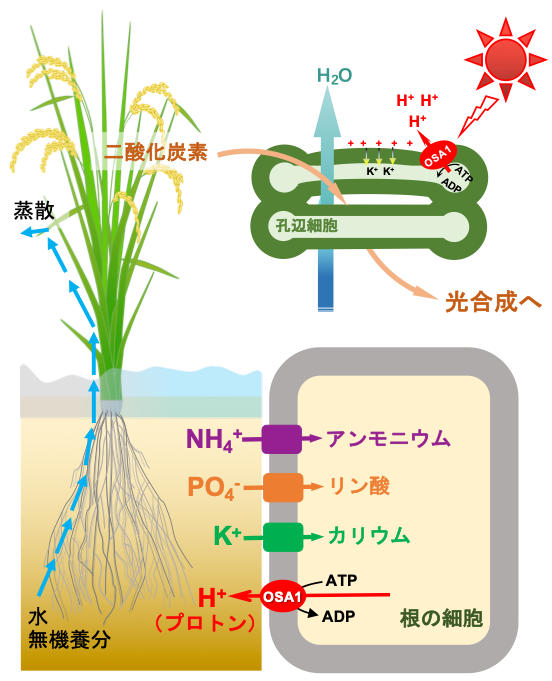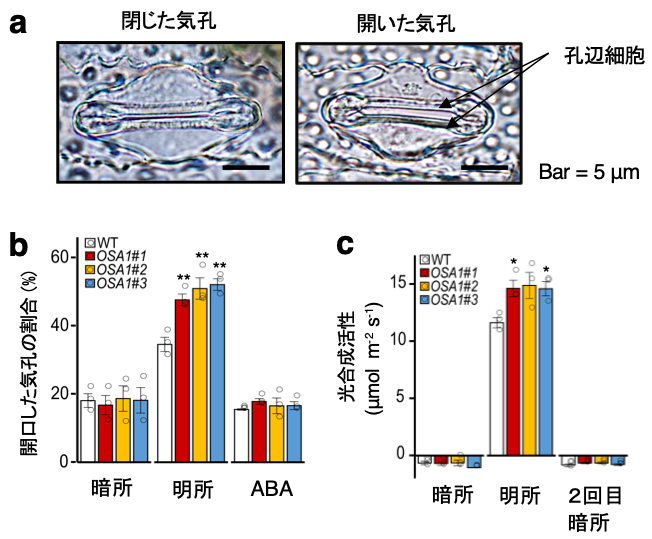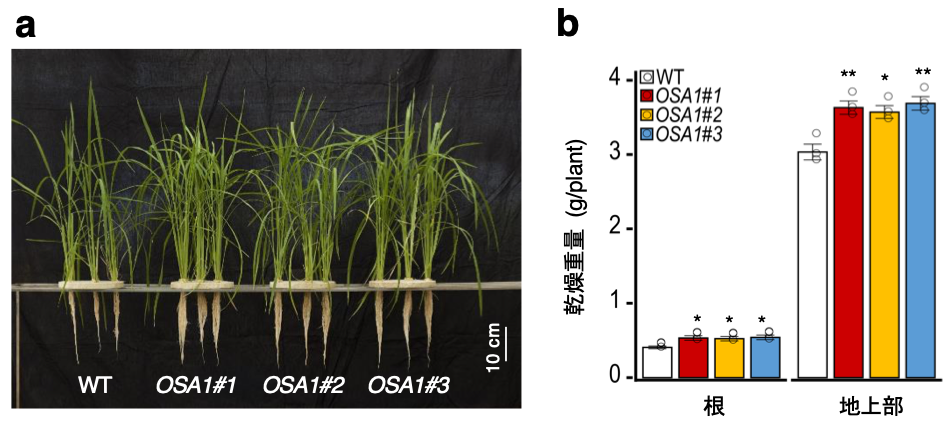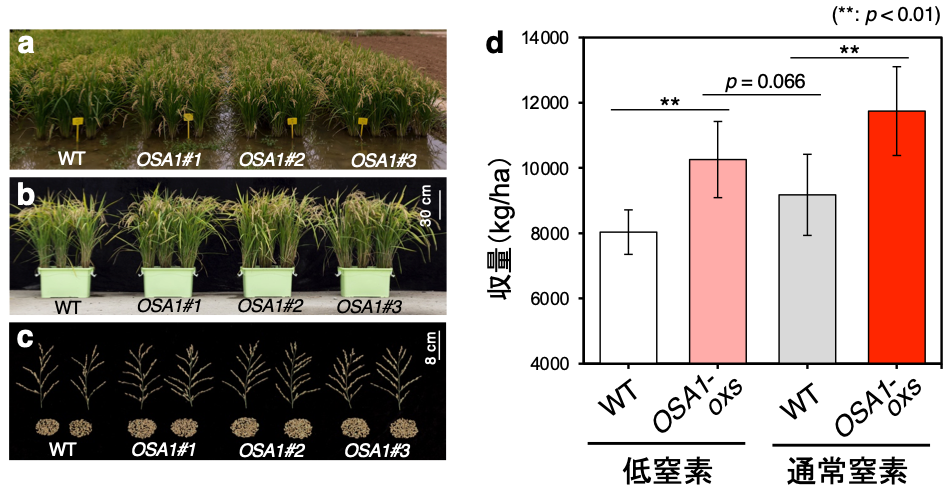Research Highlights
A novel system for increasing rice crop yield
The group of Professor Toshinori Kinoshita, of the Nagoya University Institute of Transformative Bio-Molecules (WPI-ITbM), Postdoctoral Fellow Maoxing Zhang, of the Nagoya University Graduate School of Science, and Professor Yiyong Zhu, of Nanjing Agricultural University, have developed a technique which, by increasing the number of a particular gene (the plasma membrane proton pump) in rice, simultaneously increases the nutrient uptake through the roots and the opening of the stomata, thus increasing the yield of outdoor grown rice by over 30%.
In their previous research, the group had found that the plasma membrane proton pump played an important common role with nutrient uptake in the roots and stomatal opening. When they created a variant of rice with an overexpression of a particular plasma membrane proton pump gene, they found that nutrient uptake through the roots increased by over 20%, and photosynthesis by over 20%. Growth experiments at four separate rice farms with different growth conditions showed an increase in overall rice yield of over 30%. The success of this research is a groundbreaking achievement, with its simultaneous effect upon nutrient uptake and stomatal opening, and is expected to see a variety of practical uses in the future.
This study is published in the online edition of British chemistry journal Nature Communications on February 2 2021.
This research was supported by a JST ALCA grant [JPMJAL1011], and JSPS grants-in-aid for Scientific Research (S) [20H05687] and (A) [20H05910].
About the research
As they take in mineral nutrients such as nitrogen, phosphorous and potassium through their roots, plants simultaneously absorb carbon dioxide through the stomata on their leaves, and grow through photosynthesis (Figure 1). Photosynthesis enables not only the farming of plants for food, but the exchange of carbon dioxide and management of the earth's environment. CO2 intake in plants occurs exclusively through the stomata, which are holes on the surface of the leaves. Stomata are made from pairs of stomatal cells, and open when exposed to sunlight, allowing for the intake of CO2 necessary for photosynthesis. It is also understood that nutrient uptake through the roots is plays an essential role in plant growth. Thus, if it were possible to open the stomata wider, increase the nutrient uptake through the roots, and thus increase the rate of photosynthesis, not only would it be possible to speed up growth and increase yield of plants, but also to reduce CO2 levels and the use of potentially polluting fertilizers. However, until now, no such method for increasing CO2 and nutrient intake simultaneously had been reported.

FIGURE 1: Opening of the stomata and mineral uptake through the roots
The stomata open in response to sunlight, taking in the CO2 necessary for photosynthesis, and carrying out transpiration. The roots take up nutrients from the soil, such as the nitrogen source ammonia, phosphoric acid and potassium. The action of the plasma membrane protein pump (OSA1) is important for both of these processes.
In the group's previous research, they had found that the plasma membrane proton pump plays an important role in this process alongside the roots and stomata (Figure 1). With that in mind, in this study, they created a variant of the rice plant with an increased expression of the plasma membrane proton pump gene OSA1 and carried out an analysis of its phenotype. They found that the proton pump overexpressed rice, when compared to a wild strain, took up over 20% more mineral nutrients, and opened its stomata over 25% wider when exposed to light (Figure 2). On further analysis, they found that its carbon dioxide storage capacity (the indicator of photosynthesis activity) was increased by over 25%, and that its dry weight (biomass) increased by 18-33% in hydroponic laboratory growth.

FIGURE 2: Increase in stomatal opening and photosynthesis activity in proton pump overexpression variant.
a) closed and open states of the stomata of a wild variant.
b) Opening of the stomata under three different conditions, left to right: dark environment, light environment, and light environment after treatment with abscisic acid (ABA), which inhibits stomatal opening.
c) Photosynthesis activity under three conditions, left to right: dark environment, light environment, and dark environment for a second time.
WT: wild plant
OSA1 #1-3: proton pump overexpression plants

FIGURE 3: Promotion of growth by proton pump overexpression
a) Wild rice plant and OSA1 proton pump overexpression plants grown in hydroponic culture for 4 weeks
b) These plants' dry weights. Proton pump overexpression plants' dry weights were 18-33% greater than the wild specimen.
With this determined, the researchers set out to find if the results could be replicated under realistic growing conditions. They conducted yield measurement exercises at four separate rice farms over the course of two years, finding that the rice with the overexpressed OSA1 gene had a yield over 30% higher than that of the wild strain. Even more interestingly, they discovered that even if the level of nitrogen fertilizer was reduced by half, it still produced a greater yield than the wild strain did with normal levels of nitrogen.

FIGURE 4: Field experiments
Plants in the field after 100 days (a), the same plants transferred to containers (b) and representative ears of rice (above) and seeds (below) from each plant (c). Proton pump overexpression plants gave a yield 27-39% higher than the wild specimen (d). Interestingly, the proton pump overexpression plants still gave a greater yield when given half the usual amount of nitrogen than wild plants which were given the normal amount. Low nitrogen plants are shown on the left of the graph, plants given the normal amount on the right.
The principle success of this research is its world-first discovery that through the overexpression of just a single plasma membrane proton pump gene (OSA1) in rice, it is possible to simultaneously increase nutrient uptake through the roots, stomatal opening, carbon dioxide intake and biomass in plants. Further, as the proton pump overexpressed rice showed a yield increase of over 30% at four different outdoor growing locations, and even had a yield higher than that of normally grown wild rice when provided with half the amount of nitrogen fertilizer, it is expected that this discovery will help to solve the two problems of food shortage caused by population growth, and pollution caused by fertilizers.
As nutrient uptake through the roots and carbon dioxide intake through the stomata are systems common to all plants, the research group intends to apply this technology to more plants in the future, calling them 'pump plants'. It is hoped that as the technology is further developed, it will be possible to move to less invasive methods such as genome editing and chemical compound control and for these plants to have a practical role in society.
Vocabulary:
1) Rice
One of the three major grains along with corn and wheat, rice is the staple food of over 3 billion people and makes up around 25% of the food consumed by humans.
2) Plasma membrane proton pump
Using ATP as energy, the plasma membrane proton pump is a primary transporter which transports hydrogen ions from the inside to the outside of the cell. The concentration gradient of hydrogen ions across the plasma membrane is used as a secondary transporter for a variety of materials. This plays an important role in the uptake of mineral nutrients such as nitrogen, phosphorous and potassium through the roots. In the stomata guard cells, activated by blue light, it powers the intake of potassium and induces the opening of the stomata.
3) Absorption of nutrients through the roots
16 of the 17 essential elements required by plants are absorbed as minerals through the roots, with carbon as the exception. The majority of this mineral absorption takes place along the electrochemical potential gradient across the plasma membrane, and is enabled by the plasma membrane proton pump.
4) Stomata
Holes formed by pairs of guard cells on the plant's surface, which carry out gaseous exchange with the atmosphere. The opening of the stomata is regulated by a variety of environmental signals. Activation of the cell membrane proton pump is required for opening of the stomata in response to light.
5) Photosynthesis
A chemical reaction in plants containing chloroplasts and chlorophyll, in which light energy is used to turn water and carbon dioxide into carbon compounds and oxygen. Almost every animal on Earth is reliant on the carbon compounds created by plants during photosynthesis as an energy source.
6) Abscisic acid
Abscisic acid (ABA) is a plant hormone, synthesized in response to stressors such as drought. Induces stomatal closing, seed dormancy, growth control etc.
Journal information
The article 'Plasma membrane H+-ATPase overexpression increases rice yield via simultaneous enhancement of nutrient uptake and photosynthesis' by Maoxing Zhang, Yin Wang, Xi Chen, Feiyun Xu, Ming Ding, Wenxiu Ye, Yuya Kawai, Yosuke Toda, Yuki Hayashi, Takamasa Suzuki, Houqing Zeng, Liang Xiao, Xin Xiao, Jin Xu, Shiwei Guo, Feng Yan, Qirong Shen, Guohua Xu, Toshinori Kinoshita and Yiyong Zhu is published in Nature Communications.
DOI: 10.1038/s41467-021-20964-4
2021-02-01

